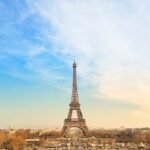The Eiffel Tower’s original purpose was to serve as the monumental entrance gateway and centerpiece of the 1889 Exposition Universelle, marking the French Revolution’s centennial and showcasing France’s cutting-edge iron engineering with a 300-meter (984-ft) tower on the Champ-de-Mars.
Why Paris Wanted a 300-Meter Tower in 1889
France planned a vast world’s fair for May–October 1889 to celebrate the Revolution’s 100th anniversary and to stimulate a country emerging from recession. Organizers launched a competition for a spectacular “tower of three hundred meters” to dominate the fairgrounds and welcome visitors. In this setting, the tower’s purpose was both ceremonial (a triumphal gateway) and symbolic (a statement of national modernity).
After more than 100 proposals, the commission selected the plan submitted by Gustave Eiffel’s company. When completed, the Tower functioned as the fair’s grand portal, guiding millions toward exhibits on the Champ-de-Mars. Its very height was the message: France could build the world’s tallest structure with industrial precision and speed — in just 2 years, 2 months, 5 days.
Entrance Gateway & Centennial Message
Contemporary guides and later encyclopedias describe the Tower explicitly as the entrance gateway to the 1889 fair, erected to crown the Revolution’s centennial and present France as a leader in steel/iron engineering. In other words: the original purpose was civic celebration plus industrial showpiece — not radio, not tourism figures, not military use.
| Year | Stated Purpose / Role | Notes |
|---|---|---|
| 1884–1886 | Design for a 300-m iron tower | Competition concept for the 1889 fair; patent filed in 1884. |
| 1887–1889 | Construct centerpiece & gateway | Built on Champ-de-Mars; opened to fairgoers. |
| 1898–1903 | Science platform (wireless) | First wireless telegraph trials; then a permanent radio station. |
| 1909–1913 | Radio saves it from demolition | Twenty-year concession ends; radio utility secures permanence. |
| 1914–1918 | Military communications | Intercepts and signaling during WWI. |
| 1957–today | Broadcasting & tourism | TV antenna (1957); current height about 1,083 ft (330 m). |
How the Eiffel Tower Fulfilled Its Purpose During the 1889 Fair
The Tower’s purpose was not abstract; it was operational. Placed on the Champ-de-Mars at the heart of the Exposition Universelle, it acted as a monumental gateway that oriented visitors the moment they arrived. The four great legs framed approach routes, created a broad shaded plaza for queues and performances, and visually “pulled” people toward the fair’s pavilions. Its sheer height — 984 feet (300 meters) in 1889 — signaled from miles away that this was the fair’s main axis and ceremonial center.

The Tower also delivered on the fair’s practical goals: move people, keep them engaged, and help finance the event. Ticketed elevators carried crowds to viewing platforms at roughly 187 ft (57 m) and 377 ft (115 m), with a summit platform near 906 ft (276 m). Restaurants and promenades on the first level converted footfall into revenue and comfort, while panoramic views helped visitors plan which national pavilions to see next. Contemporary counts report about two million ascents in 1889, proving the Tower functioned as both a ceremonial gateway and a people-moving, revenue-generating centerpiece — precisely the purpose the organizers intended.
Gateway, Orientation, and National Message
As an entrance landmark, the Tower concentrated arrivals beneath its arches, created a natural meeting point, and served as a vertical signpost visible across Paris. Its 300-meter brief tied directly to the French Revolution centennial, turning the structure into a national statement that visitors literally walked through on their way into the fair.
Visitor Experience, Circulation, and Fair Finance
Elevators and stairs offered tiered price points, the viewing decks spread crowds vertically (reducing congestion on the grounds), and on-site amenities encouraged longer stays. In short, the Tower was designed to work for the exposition: attract, orient, elevate, and monetize visitor interest — all while embodying France’s modernity.
| Original Fair Purpose | On-Site Feature (1889) | Outcome in 1889 |
|---|---|---|
| Monumental gateway & centennial symbol | 300-m (984-ft) tower with four arches framing arrivals | Clear entry focus; iconic national statement visible city-wide |
| Orient and distribute crowds | Plaza under the legs; elevated decks at ~57 m (187 ft) and ~115 m (377 ft) | Natural meeting point; vertical circulation reduced ground congestion |
| Generate revenue for the exposition | Paid ascents (elevators/stairs), restaurants, promenades | ~2 million ascents in 1889; strong receipts and repeat visits |
| Showcase modern France through experience | Safe mass-elevator rides, night illuminations, panoramic Paris | Memorable “wow” factor aligning spectacle with civic purpose |
From Fair Centerpiece to Science Platform (1890s–1910s)
After the fair closed, Eiffel offered the Tower to science, encouraging experiments in meteorology, physics, and — crucially — wireless telegraphy. On 5 November 1898, engineer Eugène Ducretet transmitted Morse code between the Tower and the Panthéon (~2.5 miles / 4 km). In the early 1900s, a permanent radio station was installed near the south pillar. These uses were not the Tower’s original brief, but they rapidly became its justification.
By 1909, Eiffel had also set up an aerodynamics lab by the Tower with a wind tunnel to test airflows — pioneering research later moved to a permanent facility in the 16th arrondissement. These scientific roles turned a fair monument into an urban laboratory, helping aviation and radio mature in France.

Wireless telegraphy: 1898–1903
Ducretet’s 1898 trials proved range and reliability; by 1903, Paris–Panthéon links and longer paths existed, turning the Tower into a strategic communications mast well before WWI.
Aerodynamics & meteorology: 1909–1912
Eiffel’s wind-tunnel and weather work leveraged the Tower’s height to measure air behavior and improve early aircraft and ballooning — again, post-fair roles that preserved the structure’s value.
How Radio Saved It from Demolition
The Tower was erected with a 20-year concession; many expected it to be dismantled around 1909. Eiffel and the city, however, recognized the military and scientific utility of a tall radio mast. The operator credited the Tower with a “scientific purpose,” and it stayed — later aiding wartime communications and, eventually, TV broadcasting.
History accounts describe WWI uses (intercepts, alerts) and the permanent radio center established near the south pillar by 1909. In short: though not the original purpose, radio became the decisive reason it survived.
What the Original Purpose Was Not
Not built as a radio tower. Wireless use came a decade later. The 1889 brief was a monumental gateway and technological showpiece for the Exposition Universelle.
Not intended as permanent at first. The Tower was widely seen as a temporary installation with a 20-year permit; permanence followed from utility and popularity.
Not just decorative. Its shape is the outcome of structural calculus for wind loads — elegance emerging from engineering necessity.
FAQ
Was the Eiffel Tower originally meant to be temporary?
Yes. It was built with a 20-year concession, expected to be dismantled c. 1909. Radio and scientific roles justified keeping it, and it later became vital for broadcasting.
So what exactly was the original purpose?
To act as the entrance gateway and centerpiece of the 1889 Exposition Universelle and to display France’s industrial prowess with a 300-meter iron tower on the Champ-de-Mars.
Who designed the Tower?
Gustave Eiffel’s firm built it; the core concept came from engineers Maurice Koechlin and Émile Nouguier, with architect Stéphane Sauvestre refining the look.
How tall is it today vs. 1889?
1889: about 984 ft (300 m). Today, with antennas, about 1,083 ft (330 m). Base spans roughly 410 ft (125 m) per side.
When did radio experiments start on the Tower?
In 1898 with Ducretet’s wireless Morse tests to the Panthéon (~4 km), followed by a permanent station by the early 1900s.
Did the Tower play a role in WWI?
Yes. It relayed communications and warnings; its strategic radio function reinforced the case for keeping it permanently.
What Did We Learn Today?
- The Tower’s original purpose was a gateway and showpiece for the 1889 world’s fair.
- Its 300-m (984-ft) height was a deliberate industrial boast and wind-tuned engineering experiment.
- Wireless telegraphy (from 1898) and later broadcasting were later roles, not the initial brief.
- A 20-year permit nearly doomed it; radio saved it from demolition around 1909.
- Today it stands about 1,083 ft (330 m), still a working antenna and France’s most iconic landmark.





